Types of Small House Flies (With Pictures) – Identification and Control

Small flies buzzing around your kitchen, living room, or bedroom are more than a nuisance. Many species of small house flies can carry disease as they feed on garbage, emerge from drains, or crawl over decaying plant matter. And getting rid of tiny house flies can be challenging because it’s difficult to locate the source.
Generally, getting rid of flies in your home requires control methods like removing the food source, destroying breeding grounds, and preventing them from returning. In addition, it is vital to store food in airtight containers, clean up any spills, or keep the garbage can lid tightly closed.
Identifying types of small house flies is key to eradicating them. Unfortunately, some of the tiniest house flies look similar. For example, fruit flies, drain flies, and fungus gnats look similar. However, they come from different sources — rotten fruit, drain sludge, and damp soil. Therefore, to get rid of the flying bugs for good, you’ll need to identify them to know where to kill them at the source.
Do you have problems with flies in the house? If so, this article is for you. This is a comprehensive guide to identifying the most common types of small house flies. You will also get helpful tips on eradicating pesky flying critters from your home.
Where Do House Flies Come From?
Although they seem to appear all of a sudden, house flies typically come from their feeding areas. The tiny flies enter homes through open windows or on things brought home. They lay eggs on garbage, pet food, drain sludge, rotting food, damp soil, or feces. The eggs hatch and larvae turn into pesky flies.
Common Types of Small House Flies
Species of small house flies are typically found in the kitchen but are also common in other rooms in the house. Here are the four types of flying critters commonly found in food preparation areas, bathrooms, or living rooms:
Fruit flies: The common kitchen bugs are tiny yellowish-brown oval flies with two large red eyes. Typically found near rotting or fermenting fruit.
Common house flies: These dark gray, slightly hairy flying pests have six legs and a small oval body measuring around 0.19” (5 mm) long.
Drain flies: These winged bugs are gray, with a fuzzy appearance making them look like tiny moths. As the name suggests, they typically live in drain slurry.
Fungus gnats: A common house fly species with a slender body measuring 0.11” (3 mm) long. Often mistaken for fruit flies, fungus gnats live in houseplant soil.
How to Control Small House Flies
Eliminating small house flies requires a multi-method approach. First, locate the source of the fly infestation and remove the food. This may mean cleaning drains, removing garbage, or trashing rotting fruit or vegetables. Next, thoroughly clean the surfaces with a vinegar solution to kill bacteria.
As an extra control method, you can use sticky traps or homemade vinegar traps to catch the nasty little critters. This way, you can check to see if your eradication methods are effective.
Types of Small House Flies (With Pictures)
There are many types of small house flies, ranging in size from less than 0.11” (3 mm) to just under 0.39” (10 mm). You can find the tiny flies buzzing around your house, making a nuisance of themselves. Small flying insects can also be found in decaying matter, garbage, or decaying plant matter.
Fruit Fly (Drosophila melanogaster)

Fruit flies are tiny brown house bugs that especially like sweet rotten fruit
Fruit flies are tiny flying pests commonly active indoors in summer when fruit or vegetables start to decay. The tiny house flies measure 0.078” to 0.15” (2 to 4 mm) long. Their characteristic features include an oval yellow-brown body, red compound eyes, and transparent wings. However, fruit flies are so tiny it’s difficult to see their features.
You can usually identify fruit flies because they hover around fruit bowls, trash cans, and spilled sugary liquids. As the fruit becomes overripe and starts to spoil, you may see the number of fruit flies increasing. They are also called vinegar flies because they are attracted to fermented liquids.
Fruit flies get into homes through open windows and cracks. Even if you have fly screens, the tiny critters can be small enough to get through the mesh.
You can tell fruit flies apart from other houseflies because they are typically the tiniest flies in the house. They may look like fungus gnats; however, fungus gnats hover around houseplants, not decaying garbage and mushy fruit.
Although fruit flies don’t bite, they can carry bacterial diseases and contaminate surfaces. Additionally, consuming fly-infested food could cause mild intestinal upset, nausea, and diarrhea.
House fly control
Prevent fruit flies from infesting your home by keeping food stored in airtight containers and refrigerating them promptly after purchase. Furthermore, overly ripe fruits and rotting vegetables should be put in the outdoor trash. It’s vital to eliminate breeding sites for complete control.
You can also make a vinegar trap to kill fruit flies, drain flies, and gnats. To do this, pour one cup of apple cider vinegar into a small bowl and add a small amount of liquid dish soap. Next, put plastic wrap over the jar and seal it with a rubber band. After that, poke small holes in the top with a toothpick.
The flies or gnats are attracted to the fermenting liquid and get in through the holes. They then land on the vinegar, and the soap in the liquid causes them to sink and drown.
Drain Flies (Psychodidae)
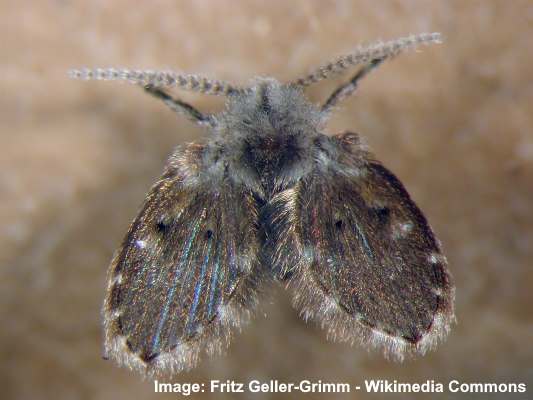
Drain flies are tiny flying house bugs with brown-gray furry look that are commonly found near drainage systems
Adult drain flies are tiny grayish-brown flies with hairy bodies and broad oval wings. The fuzzy moth-like house flies are usually found near drains in sinks, bathtubs, and other drainage systems. The minute dark gray to black house flies measure 0.078” to 0.19” (2 to 6 mm) long.
Although you may see them coming out of sink drains, drain flies don’t enter the home through the drainage or sewage system. Instead, drain flies get into your house through open windows and doors. The stink from waste products attracts them to the drains.
Drain fly females lay eggs in drains, and they hatch into tiny larvae within 48 hours. The larvae feed on the bacteria and sludge in waste disposal pipes. However, the nasty flies also lay eggs in stagnant water under sinks, cracks between tiles, compost piles, or basement sinks.
House fly control
Effective drain fly control involves removing all muck, sludge, and slurry from drains. In other words, you must destroy the flies’ breeding ground. First, you should unclog all drains and then thoroughly clean the U-trap underneath sinks and bathtubs.
You could also kill drain flies in the house by making a DIY baking soda, salt, and vinegar fly-killing solution. To make a drain fly remedy, mix half a cup of table salt and half a cup of baking soda. Then, combine the dry ingredients with a cup of white vinegar in a bowl. Pour in the drain and leave overnight. In the morning, pour boiling water down the drain.
Common Housefly (Musca domestica)
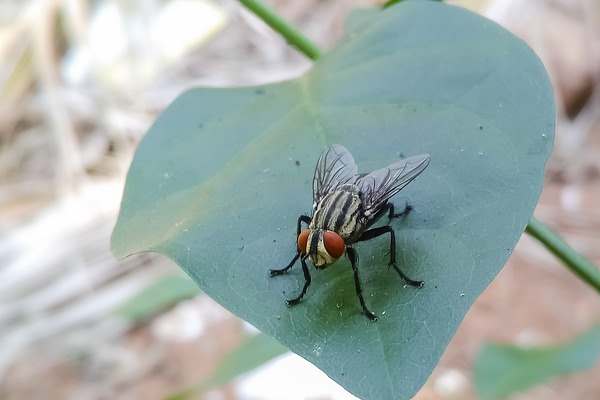
Houseflies (Musca domestica) are common small house bugs that can cause infestation in large quantities
The common housefly is a disease-carrying fly that sometimes finds its way into homes. The tiny black and gray striped fly is identified by its dark appearance, large reddish-brown compound eyes, and pair of transparent wings. Houseflies typically become a problem indoors if there is a breeding site near the property.
Houseflies don’t tend to breed indoors. Instead, the females lay eggs in compost heaps, garbage cans, food waste, feces, manure, or decaying organic matter. The white wriggling maggots hatch after a day and transform into disgusting flies after two weeks.
Houseflies aren’t just a pesky menace — they can carry over 100 diseases. Houseflies don’t bite, but their danger is from how they regurgitate food on surfaces and deposit feces on food. Of course, they are also a nuisance buzzing around rooms.
Common houseflies are easy to differentiate from other indoor flies. They are larger than fruit flies, drain flies, or fungus gnats. Furthermore, they have erratic flying behavior and make audible buzzing noises.
House fly control
The best way to get rid of common houseflies is to use a swatter. After killing the fly, disinfect any surface it landed on to reduce the risk of bacteria transmission. However, if you notice an infestation of houseflies, you should check areas in your yard for possible breeding grounds.
Additionally, window and door screens are effective ways to prevent houseflies from entering your home. Also, don’t forget to keep food stored in airtight containers or the refrigerator. And it’s never a good idea to leave pet food out overnight. This attracts flies, common crawling house bugs, and vermin.
Fungus Gnats
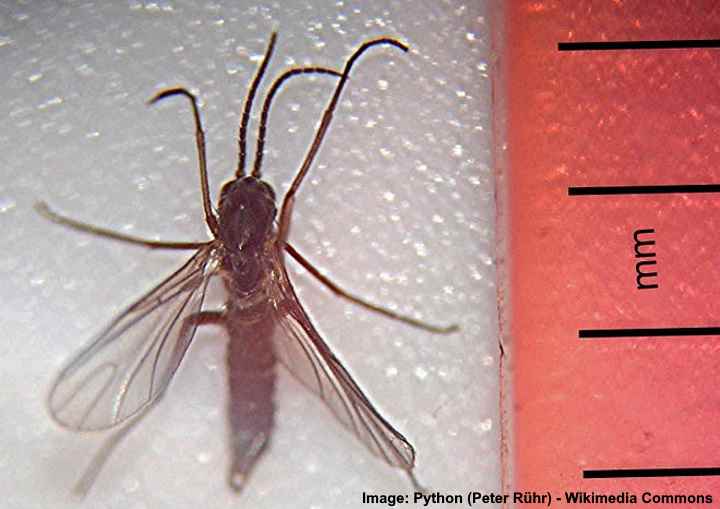
Fungus gnats are small black flying bugs that can be found in damp places in the house or near houseplants
Fungus gnats are slender mosquito-like black flies. Why are you getting so many gnats in your house? The tiny flies are common in homes with many houseplants. Fungus gnats measure 0.079” to 0.30” (2 – 8 mm) long. Their distinguishing features are a cylindrical black body, a pair of wings, and six legs; however, they are usually too tiny to identify with the naked eye.
The best way to identify fungus gnats is to observe their behavior. The females lay eggs in the top layer of moist potting soil. The larvae hatch and feed on organic matter in the plant pot. Then the small flies emerge. The black critters typically crawl over plants. However, they can fly and are often seen hovering around plants.
Fungus gnats don’t bite humans, and they rarely cause damage to houseplants. However, large numbers of flying pests can destroy seedlings.
Here are a few ways to tell the difference between fungus gnats and fruit flies:
- Fungus gnats are slender, not rounded and oval.
- Unlike fruit flies, they are not attracted to overripe fruit. Instead, they stay near houseplants.
- Fungus gnats are entirely black, whereas fruit flies are a dark brown color.
House fly control
The best way to kill fungus gnats living in houseplant soil is to make a soil rinse using a 3% hydrogen peroxide solution. Mix one part hydrogen peroxide with four parts water. Pour the liquid into the plant pot to thoroughly drench the soil. This should be enough to kill the fly eggs and larvae.
Using the right watering techniques for houseplants can prevent fungus gnat infestations. As a rule, only water houseplants when the top 2” (5 cm) layer of soil is dry. This way, you don’t give fungus gnats the right conditions to lay eggs.
With large infestations, you can use sticky traps to help reduce the number of fungus gnats.
Indianmeal Moth (Plodia interpunctella)
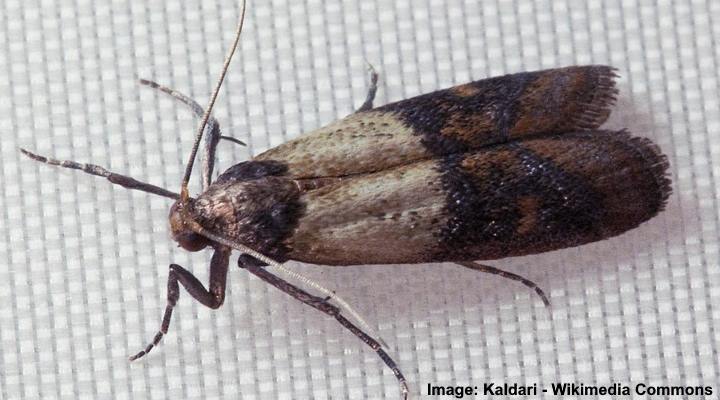
The brown and gray Indianmeal moth is commonly found in kitchens and pantries in grain products
Also called pantry moths, Indianmeal moths are a species of tiny flying insects commonly found in kitchens. The small, winged insects lay eggs in stored grains and food, where their larvae hatch and start feeding. The small flying creatures measure 0.3” to 0.4” (8 – 10 mm) long.
Signs of a pantry moth infestation are usually noticeable in stored dried foodstuffs. The kitchen bugs can get into cereals, pasta, flour, rice, dried fruits, nuts, seeds, and spices. Additionally, you may notice tell-tale signs like silky webs, frass (excrement), or small white maggots.
House fly control
The best way to eradicate pesky flying pantry bugs is to dispose of any infested foods. Then, use hot soapy water to clean the kitchen cupboards and storage areas thoroughly. Always store dried foodstuffs in sealable plastic or glass containers as a control measure.
Lesser House Fly (Fannia canicularis)
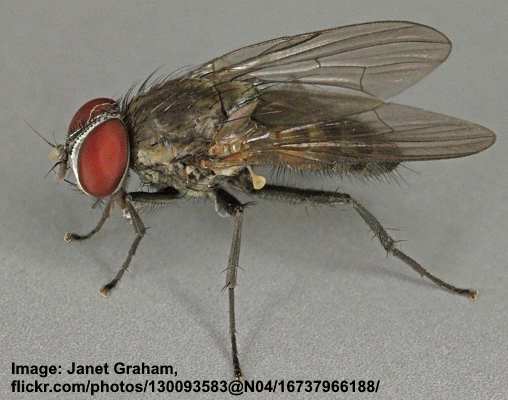
The lesser house fly is smaller that the common housefly and feeds on garbage
The lesser house fly looks like the common housefly, only that it’s smaller. The brownish-gray fly is identified by its gray body with black stripes and black legs. Like the typical housefly, this flying pest has large red compound eyes on its head. Lesser house flies measure 0.14” to 0.24” (3.5 – 6 mm) long.
It’s crucial to keep lesser house flies out of the house because they are disease carriers. The flies lay eggs on feces and rotting organic matter. They typically feed on garbage and transmit diseases when they land on surfaces.
Blowflies (Calliphoridae)
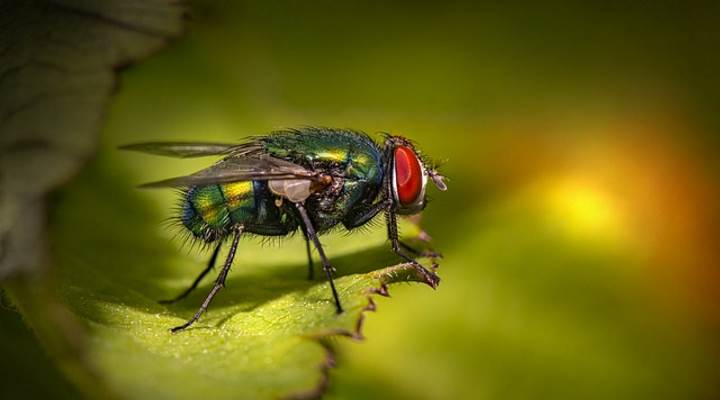
Blowflies are usually shiny metallic in their appearance and are attracted to garbage and food
Also called bluebottles, greenbottles, or carrion flies, blowflies are characterized by their metallic green or blue color. Blowflies typically measure 0.3” to 0.4” (8 – 10 mm) long. The small flies can get into the home through open windows and will search out garbage cans, pet food, or rotting organic matter.
Like other types of disease-carrying insects, it’s vital to keep blowflies out of your home. You should also prevent them from entering homes by keeping trash cans closed and storing fresh food and vegetables in the refrigerator.
Cluster Flies (Pollenia spp.)
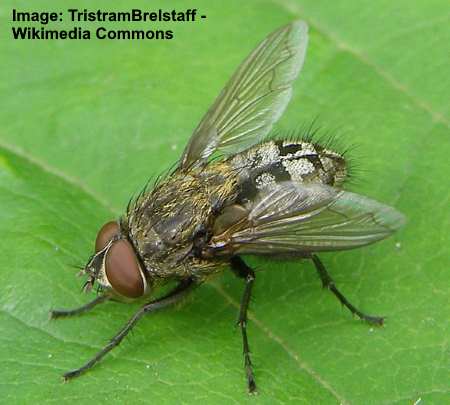
Cluster flies can be found in house attics and basements
Cluster flies are a type of harmless fly you sometimes encounter in dark, enclosed spaces — therefore, they are also called attic flies. Cluster flies have a gray abdomen with small black patches and brown compound eyes. They enter homes in cold weather and can live in attics, basements, and similar places.
Unlike common houseflies and blowflies, cluster flies don’t transmit diseases because they don’t lay eggs on human food. Therefore, the small grayish-black flies are not a nuisance pest in the house.
Phorid Flies (Phoridae)
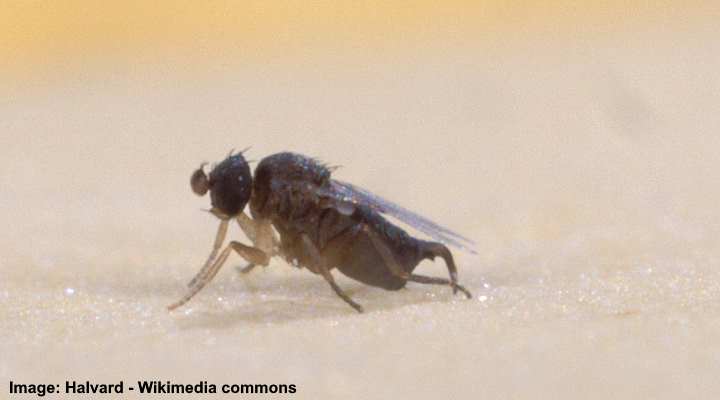
The tiny phorid flies are identified by their humpback and erratic flight and can be found in unsanitary places
Phorid flies are tiny dark-brown or black flies measuring 0.78” to 0.15” (2 – 4 mm) with a characteristic hump-backed appearance. Phorid flies are easy to confuse for drain flies or fruit flies because they inhabit unsanitary places. They search out garbage, drain pipe, moist plant soil, and decomposing organic matter.
To get rid of phorid flies, remove the source of their breeding and feeding locations. You can also use traps for fruit flies to attract, trap, and kill phorid flies.
Flesh Flies (Sarcophagidae)
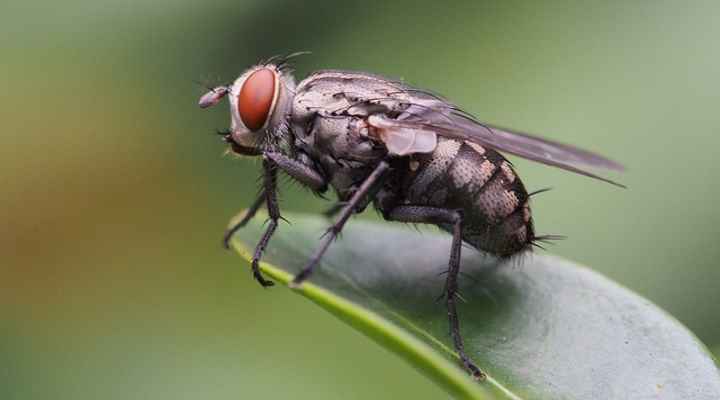
Flesh flies are small flying bugs in the house that are attracted to meat scraps
Flesh flies are medium-sized flies you can sometimes find in homes. You can identify the flies by their three black stripes on their thorax and mottled patterns on their abdominal area. Typically, flesh flies look like large houseflies measuring 0.33” to 0.5” (8.5 – 12 mm) long.
Flesh flies rarely infest homes because they typically live outdoors, feeding on rotting flesh. However, suppose you notice a significant number of flesh flies indoors. In that case, you should check around your home for any dead animals or vermin.
Related articles:
